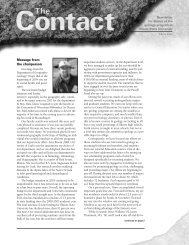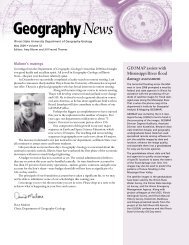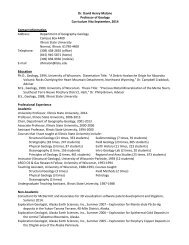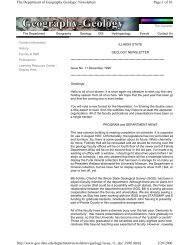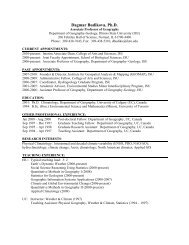Glacial Deposits.indd - Department of Geography - Geology - Illinois ...
Glacial Deposits.indd - Department of Geography - Geology - Illinois ...
Glacial Deposits.indd - Department of Geography - Geology - Illinois ...
You also want an ePaper? Increase the reach of your titles
YUMPU automatically turns print PDFs into web optimized ePapers that Google loves.
YESTERYEARS<br />
By Michael D. Sublett<br />
<strong>Glacial</strong> <strong>Deposits</strong> 30 Years Ago, Volume 8, 1979-1980<br />
Computers really were available for cartographic projects three decades ago; but the maps then<br />
emerged from “the <strong>Department</strong>’s computer mapping library maintained at Julian Hall,” according<br />
to an article that Pr<strong>of</strong>essor Donald E. Luman wrote for Volume 8, entitled “A Sample <strong>of</strong><br />
Computer Cartography Output.” Words, seldom seen now, like CALFORM, SYMVU, SYMAP,<br />
and SYMAPVU appeared in his five-page piece. These were the programs that Don, fellow<br />
geographer George Aspbury, and their students used on the mainframe computer in Julian.<br />
Accompanying his page <strong>of</strong> text were several maps, including a perspective drawing <strong>of</strong> <strong>Illinois</strong><br />
showing farmland values by county, an “isarithmic slope map…<strong>of</strong> 3300 points depicting the area<br />
encompassed by Timberline Subdivision at Goodfield,” “a planimetric line-printed map, as well<br />
as the two-point perspective line plotted map” <strong>of</strong> nationwide precipitation on 9 November 1977,<br />
and a “low-order trend surface” map <strong>of</strong> Washington state showing family income. Don soon left<br />
the <strong>Department</strong> to teach at Northern <strong>Illinois</strong> University and now works for the <strong>Illinois</strong> State<br />
Geological Survey, on the campus <strong>of</strong> the University <strong>of</strong> <strong>Illinois</strong>.<br />
<strong>Glacial</strong> <strong>Deposits</strong> 20 Years Ago, Volume 18, 1989-1990<br />
Computers made the news in the late 1980s as a novel way for registering our students. Donna<br />
L. Mau, Student Editor for Volume 18, interviewed Pr<strong>of</strong>essor Eric Johnson, the <strong>Geography</strong><br />
Advisor, for her article, “Easing Up on Registration.” Dr. Johnson told her that “the new system<br />
makes looking through a stack <strong>of</strong> student files [file folders] unthinkable.” Every record that he<br />
needed to advise majors was available “by the touch <strong>of</strong> a few keys.” If a graduating senior<br />
wanted to know whether “his or her senior hours are completed,” all Eric had to do was give the<br />
computer a “matter <strong>of</strong> seconds” to find the answer. Making life for students even easier was the<br />
computer feature that allowed “a student to change majors to <strong>Geography</strong> or <strong>Geology</strong> without all<br />
the running around back and forth between department <strong>of</strong>fices and Hovey Hall.” Donna<br />
graduated and worked several years at Walgreens headquarters. Eric Johnson retired in the<br />
late 1990s and has since passed.<br />
<strong>Glacial</strong> <strong>Deposits</strong> 10 Years Ago, Volume 28, 1999-2000<br />
Computers were playing a huge role in the preparation and publication <strong>of</strong> <strong>Glacial</strong> <strong>Deposits</strong> by<br />
the time Volume 28 appeared. In my annual editorial, I suggested that the cover that year was<br />
“worth a few lines” because for the first time, after 27 issues, we had “the chance to publish<br />
items in full color,” which we did on the inside and outside <strong>of</strong> the front and back covers. Key to a<br />
color process that the <strong>Department</strong> could afford were the Director <strong>of</strong> Printing Services, David<br />
Nelson, “and their new Heidelberg Quickmaster DI (digital imaging) color press,” which retailed<br />
“for just under $500,000.” Jill Freund Thomas, in charge <strong>of</strong> rendering our graphics (then and<br />
now), was “able to go all out with color efforts on type, logos, photographs, and maps.” I noted<br />
that we were just then beginning to use digital photographs (one <strong>of</strong> incoming faculty member<br />
Dagmar Budikova and another <strong>of</strong> President Vic Boschini). The other photos in that volume were<br />
film prints that Jill had to scan and prepare for the printing press. Dave Nelson retired in 2010,<br />
but the Heidelberg continues to march.<br />
56






